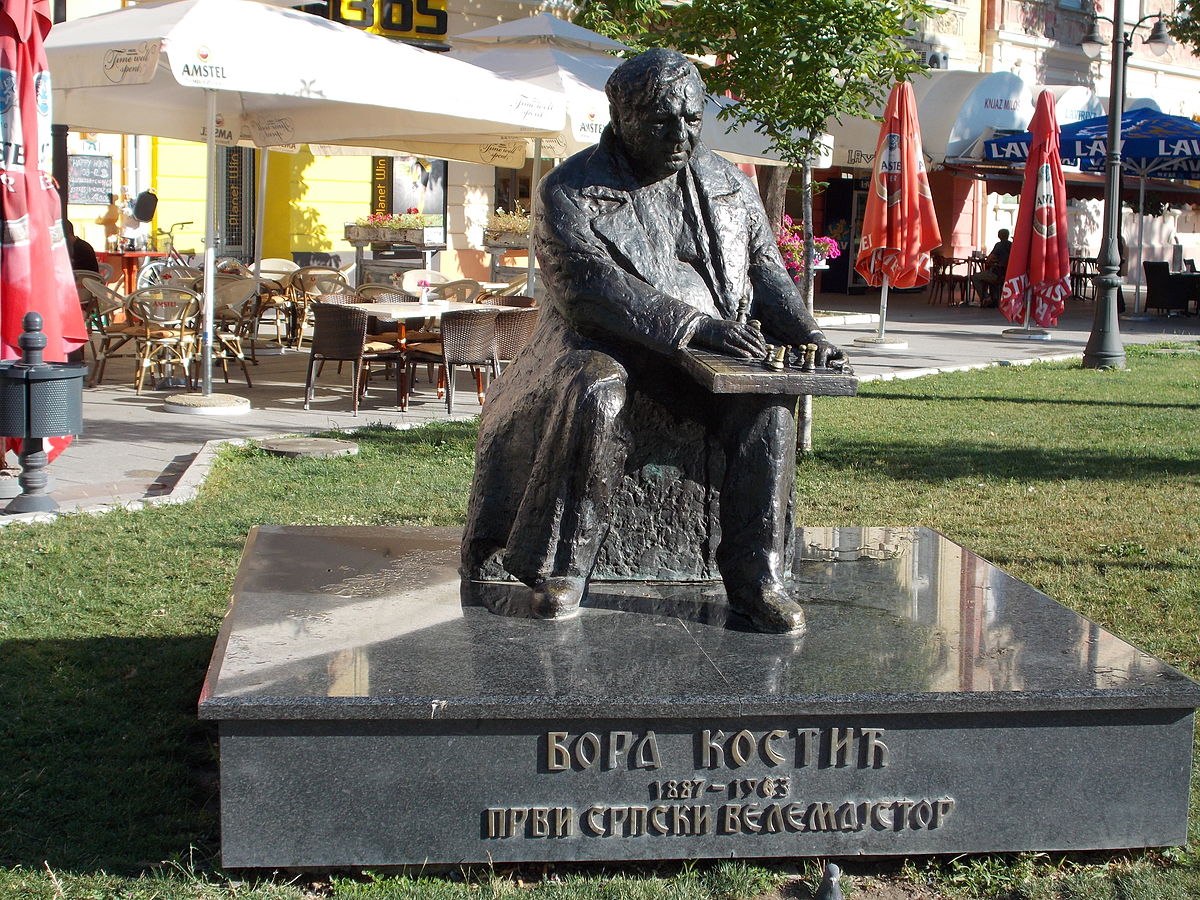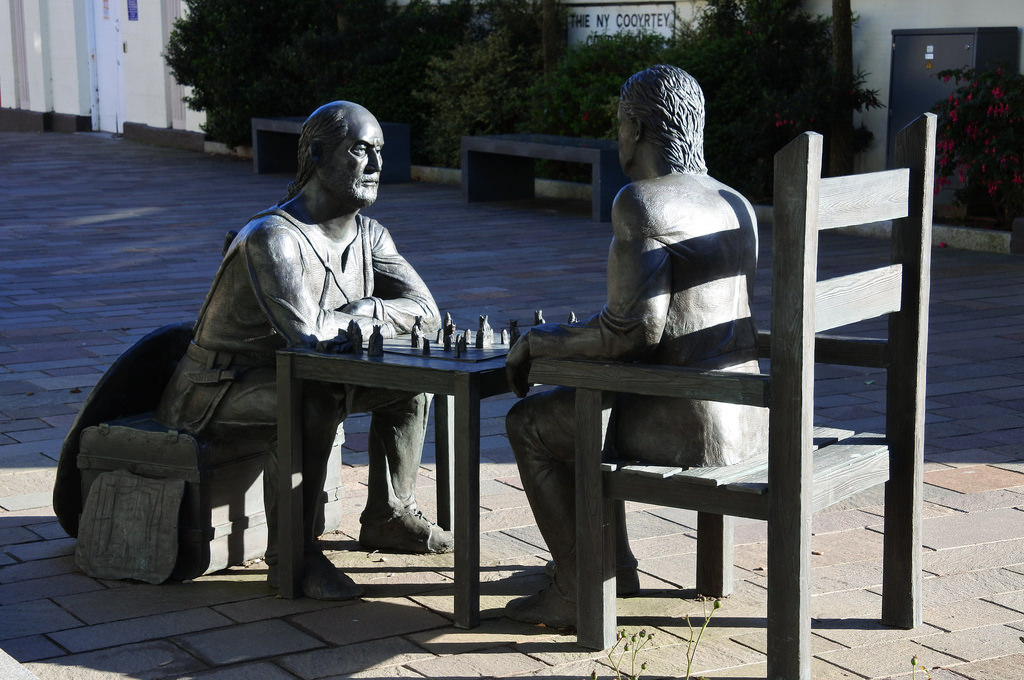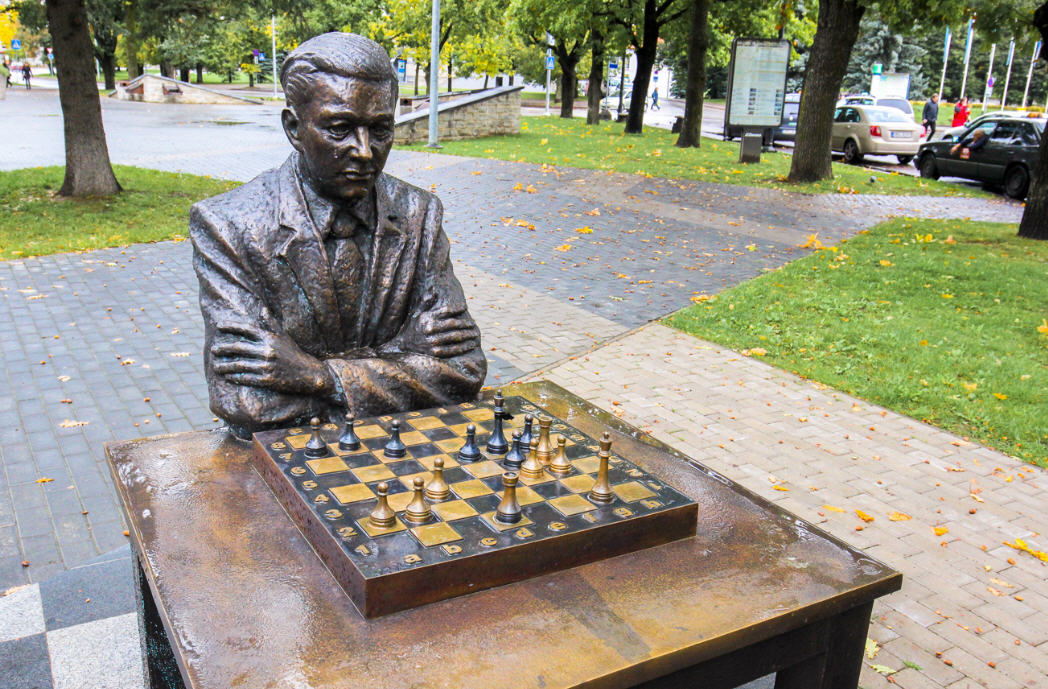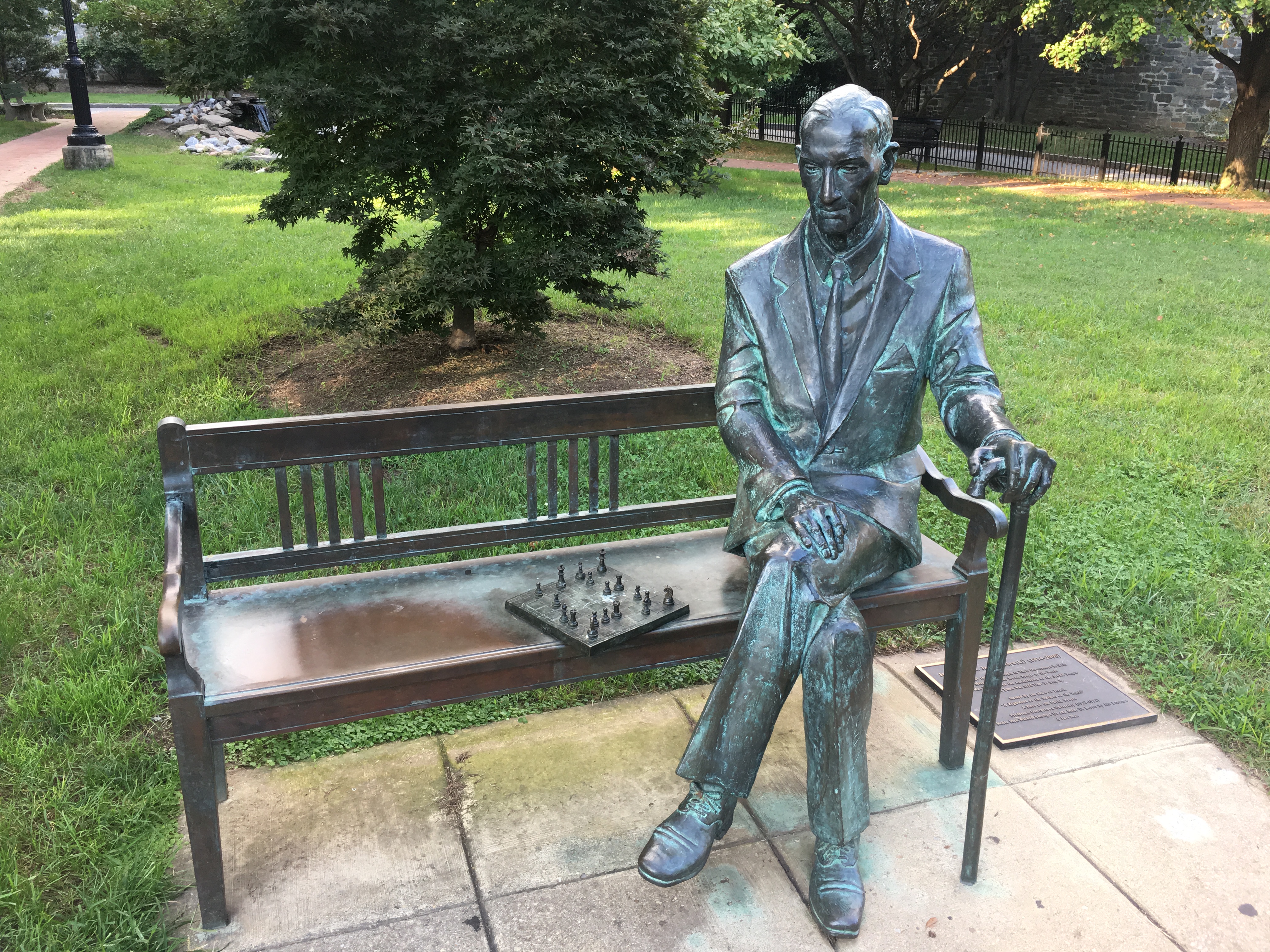Chess Public Art: Chess Sculptures
Chess public art collects all those artistic expressions about chess and chess sculptures that have been placed in public spaces all over the world. Below there is a long list of chess sculptures that I am expanding as I find a new one.

- Artist: Pete Helzer
- Title: Chess Player
- Date: 2002
- Location: Vogel Plaza – Medford – Oregon (USA).
- Description, Chess Sculptures:
Peter Helzer has produced over one hundred separate works of art for parks, plazas, and public spaces in the Pacific Northwest. His work primarily consists of interactive bronze sculptures that range from figurative to whimsical to architectural.
In this work he represents a chess player in a pensive position seated before a board, in front of him, an empty chair that provokes the reaction of the spectator.

- Artist: Unknown
- Title: Borislav Kostić
- Date: Unknown
- Location: Vršac – Vojvodina (Serbia).
- Description, Chess Sculptures:
Bora Kostic was born on 24 February 1887 in Vrsac. His first chess steps he started when he was ten. In 1911 he achieved sensational victory in the match with the American champion, Frank Marshall. In 1915 he went to New York and started the chess tour from the east to the west coast. On that famous six-month-long tour, Bora Kostic achieved the world record in the number of played games on simultaneous exhibitions. Out of 3281 played games he lost only 112, and made draw in 237.
Playing numerous games and tournaments, master tournament of the «Manhattan chess» club being the most famous in 1918, Bora Kostic was ranked immediately after Capablanca on the whole American continent. That is why he faces in a match with Capablanca at Havana in 1919. Capablanca won with the great result 5-0.
In the same year he returned to Europe and in Hastings took the second place after Capablanca. The next year in Hastings he took the first place with 100% gained points, which nobody repeated during the long tradition of this tournament. Then came important tournament results: Gothenburg 1920 – IV place, Budapest 1921 – III-IV place, Hague 1921 IV-V place. In England he played simultaneous games and blind productions, animating the chess world with enthusiasm. He died in Belgrade, 3 November 1963.
In the Cyrillic inscription at the base of the monument, the dates of birth and death appear, and it reads «First Serbian Grand Master: Bora Kostić».

- Artist: Lloyd Lillie
- Title: Chess Players
- Date: 1983
- Location: John Marshall Park – Washington, DC (USA).
- Description, Chess Sculptures:
Sculptor Lloyd Lillie’s work appears in collections around the world, including North Yemen and Saudi Arabia. In the United States, Lillie’s work is widely dispersed throughout the country, from Massachusetts to Virginia and Colorado. An Honors graduate of the School of the Museum of Fine Arts, he also studied at Maine’s Skowhegan School of Painting and Sculpture; the Corcoran School of Art in Wasington, DC; and the Academia di Belle Arti in Florence, Italy. Lillie is currently Professor Emeritus at Boston University, where he began teaching in 1961.
Two life-sized men are playing chess, neither having a great advantage. However, the older gentleman on the right holds the bishop in his hand and showing a slight smile while the other looks sad. A key piece has been won and the game’s outcome will soon follow. But you know, if the other guy moved his …

- Artist: Amanda Barton
- Title: Millennium Sculpture
- Date: 2000
- Location: Ramsey – Isle of Man (UK).
- Description, Chess Sculptures:
The Statues were sculpted by Amanda Barton for Ramsey Town Commissioners in 2000 to mark the passing into the new millennium.
The sculpture depicts two Norse Kings of Mann and the Isles each having an association with Ramsey, the Viking warrior Godred Crovan and his son and great statesman King Olaf. The two characters apparently play an innocent game of chess. King Olaf appears to be playing classical chess whilst his father, leaning across the board, plays the game as if it were the more aggressive ancient Viking game of Merels or mill.

- Artist: John Seward Johnson
- Title: The Winner
- Date: 1986
- Location:
Ohio State University – Newark’s campus – Ohio (USA).
Century Gardens – Calgary – Alberta (Canada).
Preston Park Village – Plano – Texas (USA).
- Description, Chess Sculptures:
John Seward Johnson is an American artist known for his trompe l’oeil painted bronze statues. He is a grandson of Robert Wood Johnson I, the co-founder of Johnson & Johnson. He creates life-size bronze statues, which are castings of living people, depicting them engaged in day-to-day activities. A large staff of technicians perform the fabrication. He is founder of Grounds for Sculpture.
There are at least 3 sculptures known to me in different locations: Ohio, Plano-Texas and Calgary, there will possibly be more.
With a cigar in his mouth, the man depicted in the statue bewildered the position of the board before him.

- Artist: Aivar Simson and Paul Mänd
- Title: Paul Keres
- Date: 2016
- Location: Puškin Street and Peeter Square – Narva (Estonia).
- Description, Chess Sculptures:
The monument dedicated to the 100th birthday of Paul Keres, an Estonian chess player and international grandmaster, is located on a square between Puškin Street and Peeter Square. Their idea was to make it possible for people to sit opposite to Keres behind the chessboard and think about the next move.
The monument depicts the game between Paul Keres and Walter Browne in Vancouver in 1975.

- Artist: Karol Badyna
- Title: Jan Karski
- Date: 2002
- Location:
George Town University – Washington, DC (USA) – 2002.
37th Street and Madison Avenue (renamed as Jan Karski Corner) – New York (USA) – 2007.
Tel Aviv University – Tel Aviv (Israel) – 2009.
rzeką Silnicą – Kielce (Poland) – 2009.
- Description, Chess Sculptures:
The monument of Jan Karski portrays an elderly gentleman sitting on a bench over a chessboard. Everything about it, including the situation, is painfully realistic. Karski, a legendary courier of the Home Army who revealed the truth about the Holocaust in London and Washington, was a professor at the School of Foreign Service at the Georgetown University. On his monument, which is unusually low, without a plinth, he has his own features and silhouette. Also the fact that he liked playing chess and was a good player is depicted.
On a plaque on the ground it reads: «Jan Karski (Jan Kozielewski), 1914-2000, messenger of the Polish people before his government in exile, messenger of the Jewish people to the world, the man who warned about the annihilation of the Jewish people when there was still time to stop her. Named by the State of Israel Right Among the Nations, hero of the Polish people, professor at Georgetown University (1952-1992), a noble man who walked among us and made us better by his presence, a just man. »
There are 4 sculptures in diferent locations: Washintong DC, New York, Tel Aviv – Israel, Kielce – Poland.

- Artist: Redas Diržys
- Title: Šachmatininkas (Chess Player)
- Date: 2003
- Location: Senvagé Park – Panevėžys (Lithuania)
- Description, Chess Sculptures:
The artistic composition shows a bronze sculpture that reflects a chess player behind a stone table with five chess boards. On the far right of the board you can read the following text in Lithuanian language «ast kviečia sulošti partiją» which means a invitation to play a game of chess.
The sculptor has chosen the American boxer Mike Tyson as model for his chess player. To see more details of the chess player sculpture, here I leave other photos 1 , 2 , 3.

- Artist: Wang Chain Kiang
- Title: Šachmatininkas (Chess Player)
- Date: 2012
- Location: University Tunku Abdel Rahman campus – Kampar (Malaysia)
- Description, Chess Sculptures:
Sculpture showing Confucius and Einstein engaged in playing chessin a fictional chess match. Confucius and Einstein are playing Chinese Go and Western Chess respectively. On my personal perception, maybe it would have been more consistent to choose Chinese Chess or Xiangqi instead of Go.
Anyway, the sculpture shows the differences between East and West, between thoughts separated by more than 2000 years in time, a blending views of the cultural wisdom and thought of Confucius to the progressive nature of modern technology of Einstein.
